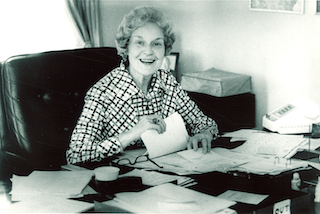
The challenges of leading the Republican Party precipitated endless letters and reports for Mary Louise Smith who is pictured at her desk in 1968. Photo courtesy of the University of Iowa Libraries, Iowa Women’s Archives
May/June 2024 (Volume 16, Issue 3)
By Timothy Walch
“Madam Chairman.” That title must have been music to her ears when she was greeted in the White House’s Oval Office by President Gerald R. Ford. It was in the fall of 1974 when Ford chose Mary Louise Smith to become the first female chair of the Republican National Committee (RNC). It would be a high point in the remarkable career of a woman from Eddyville.
Smith served as chair of the RNC from 1974 to 1977, years that were tumultuous in national politics. Richard Nixon resigned the presidency in August 1974 and the impact on the Republican Party directly affected the congressional elections in November.
She picked up the pieces and rebuilt the party under the leadership of Ford. During the years that followed she faced significant challenges to her authority and resistance to her plans for the future of the party.
Born Mary Louise Epperson in Eddyville on Oct. 6, 1914, she was the second child of Frank Epperson and Louisa Anna Jager. She lived an idyllic childhood showing a talent for speech and communications, skills that would be useful in later life.
The Eppersons left Eddyville in 1929 and moved to Iowa City. Mary Louise enrolled at Iowa City High School and her older sister, Lynette, attended the University of Iowa. Life in a university town was enlightening for Mary Louise and she quickly acquired enough credits to enter the University of Iowa in the fall of 1931.
She began her college years by using her communication skills. “Over the decades,” writes Smith’s biographer Suzanne O’Dea in her 2012 book, “Madam Chairman,” “Mary Louise would transform that charming connection with a college audience into a powerful speaking style that could motivate and energize Republican audiences across the country.”
On a chance trip to a local roadhouse, Mary Louise met Elmer Smith. They enjoyed each other’s company and eventually married in a simple ceremony in 1934. They kept the marriage a secret, eventually telling their parents as graduation loomed.
Smith came to realize that her communication skills alone would not get her a job. She changed her major to social work, received her degree in 1935, and found work with the Iowa Employment Administration.
The couple had two children — Robert (1937) and Margaret (1939) — as they settled into married life in central Iowa. World War II took the Smiths around the United States, and they had a third child, James, in 1942. In October 1945, Smith’s husband opened a medical practice in Eagle Grove.
Smith loved her life as a wife and mother but wanted more. By the 1950s, she was leading the local Community Chest campaign and later served on the school board. Still restless, she saw that her best opportunity to have influence was in service to the Republican Party.
TO READ THE ENTIRE STORY AND OTHER FASCINATING STORIES ABOUT IOWA HISTORY, subscribe to Iowa History Journal.
